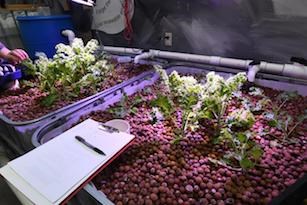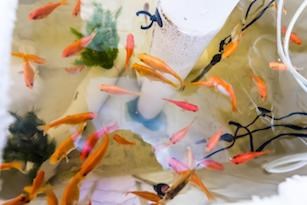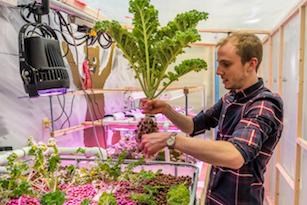The Squamish area is becoming a bit of a hotbed for an innovative agricultural technique called aquaponics.
Don Ross Middle School has been part of a project for a couple of years, with students applying scientific testing to water and soil to maximize plant productivity. Started with funding from Squamish Climate Action Network (Squamish CAN) and the school's PAC, and with the know-how of Jonathan Luckhurst of Sea To Sky Aquaponics, students oversee a sustainable food production system.
Aquaponics may be verging on a big leap as another local company – Echoflex Solutions – was bought out at the end of last year by a major U.S. conglomerate. For Echoflex founders Brian Aikens and Shawn Pedersen, aquaponics wasn't the original plan. It's more of a side-gig that emerged from their main line, which is wireless sensors and related equipment.
"The main thing that we do is around commercial building control," said Pedersen. But the application of their solar-powered, wireless technology to food production made sense from productivity and environmental sustainability perspectives.
The sensors they had been developing since 2005 to remotely control lighting, heating and other logistics in commercial buildings were fairly easily adapted to measure and control things like dissolved oxygen and pH levels in water, moisture content in soil, and light levels and quality.

In a small pilot project in their Squamish headquarters, Echoflex has a tank with about 100 goldfish. The fertilized water the fish produce is recirculated to feed plant beds where kale, lettuces, and tomatoes grow.
"It's a closed-loop system where the water circulates from one to the other and then back to the top again," he said. "That means that we are using our sensor technology not only for the fish and the water conditions that the fish live in but also for the plants in the soil."
Depending on the reports from the sensors, aspects of the growing conditions can be remotely shifted for maximal growth production.
For example, Pedersen said, "By changing the spectrum of light and that kind of thing during the growing cycle, depending on the types of plants, you can encourage better growth."
Not only are soil and water conditions monitored wirelessly, all the equipment is entirely powered by solar electricity, eliminating the time-consuming need for regular battery replacement as well as the environmental impacts of discarded batteries. And, although one of Echoflex's biggest applications so far is 14 ocean-based fish farms in Greece, the amount of sunshine is fairly irrelevant.
[The company’s current primary focus is land-based farms, one of which they are currently monitoring on Vancouver Island.]
"Our products work on such low, low power requirements that we don't need much light," he said. "Our products are all working in our building here and there are some that are in the corners up at the top that don't get a lot of light, but they still function well. … If the product's fully charged, they can operate up to 15 or 20 days without seeing light again, that's how efficient the circuitry is in our products."
The new parent company, Wisconsin-based Electronic Theatre Controls, also did not start out in the agriculture sector, specializing instead in theatrical and studio lighting systems. The first connection between the two was a 2012 partnership to help ETC apply wireless sensor systems to their existing lines.
The parent company's 1,200 worldwide employees and large manufacturing hub allow Echoflex and its 13 Squamish-based employees to stay focused, Pedersen said.
"It allows us to scale up in a bigger way, to focus and what we're good at, which is engineering and sales and marketing and they take care of everything else," he said.
The business started in Squamish because that was where the principals happened to be. But, in the early years, location helped spur growth.
"When we first started the company, it was very easy to find young, bright, energetic engineers who wanted to come to Squamish not only to work but to play," he said. "Our first three or four engineers that we hired were either kite-boarders or mountain-bikers or rock-climbers and we sort of started the company on the premise that when it's a better day to play, go play, and when it's otherwise come in and work and we went along that way for a number of years, and it went really well."
The problem more recently, he said, is finding employees who can afford to move to Squamish, where housing prices have spiked, and availability has plummeted.
Krystle tenBrink, a director of Squamish CAN, said aquaponics is burgeoning in the province.
"We have seen more aquaponics facilities popping up throughout B.C.," she said. "In terms of thinking about how we are going to feed our community members, I think it's worth exploring traditional and alternative and innovative ways to grow healthy, nutritious food where our community members will have access to that. I don't necessarily think it's a one-stop shop, the one thing [that's] going to replace traditional agriculture or traditional ways of growing things ... But I think it's worth exploring creative solutions and creative opportunities, using technology, which is what this is doing."




